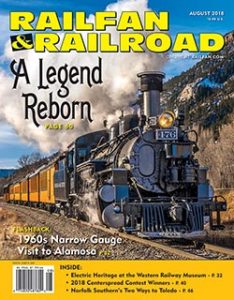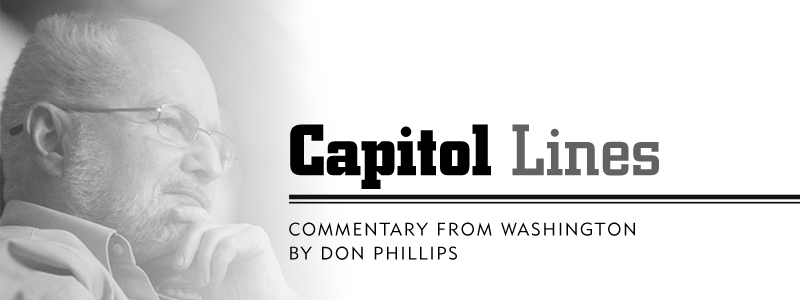 Editor’s Note: This month we welcome veteran transportation policy columnist Don Phillips to the pages of Railfan & Railroad, continuing the Capitol Lines column crafted for more than 14 years by Wes Vernon. We’ll let Don take it from here. —S.B.
Editor’s Note: This month we welcome veteran transportation policy columnist Don Phillips to the pages of Railfan & Railroad, continuing the Capitol Lines column crafted for more than 14 years by Wes Vernon. We’ll let Don take it from here. —S.B.
This is my first monthly column for Railfan & Railroad. Many of you probably remember me from my days at Trains as the “Potomac Pundit.” After my tenure there ended, I was quickly greeted with invitations to write for this magazine as well as sister publication Passenger Train Journal, and the online version of industry stalwart Railway Age. I’ve spent most of my journalistic career covering all manner of transportation policy for major media outlets from United Press International to the Washington Post, and I look forward to sharing my insights and analysis with you here each month.
In any industry, the one constant is change, and railroading is no different. There are so many subjects I plan to cover over the next year that it will be difficult to determine what to leave out.
Anderson’s Amtrak
One of the issues of great interest to our readers is the recent challenges and abrupt changes to our American passenger train system brought about by Amtrak CEO Richard Anderson. While Anderson comes from a railroad family, most of his work experience is with airlines. He was head of Delta Airlines for several years, which led to a derisive nickname among railroaders, “Delta Dick.” He proves regularly that he doesn’t know much about Amtrak or railroading. He actually seems to believe that the Northeast Corridor makes money and Amtrak’s losses are the fault of long-distance trains. The truth is quite the opposite. The NEC is the big money loser, while long-distance trains have a much better operating ratio (while still showing a loss). Many costs are fixed and spread across the Amtrak system. Any costs not paid by long-distance trains would be shifted to other routes, mainly the Northeast Corridor. While Amtrak officials seem to say Anderson doesn’t want to kill the long-distance business, few railroaders (or railfans) believe it.
Long-distance or otherwise, there is really no chance he will kill any trains outright, shift any trains to a different route, or change any trains to tri-weekly. Many politicians have served notice they won’t allow it. In a way, that is a shame because some routes probably do need to be reconsidered. However, as long as Anderson is president, nothing new or better is likely to happen.
Here’s something else that won’t happen — no route will be killed or suspended because it doesn’t have positive train control (PTC). Anderson seems to believe that all passenger trains must operate on routes equipped with PTC. That simply isn’t so; one factor is how many freight trains use the line and how much hazardous material they haul.
One reason we don’t understand Anderson’s intentions is that he won’t talk to the news media. There are even a few instances in which he has been nasty and walked away after discovering that he was talking to a reporter. It is simply unbelievable that a CEO won’t talk to the press or hold a proper news conference. Instead, we are forced to glean meaning from leaked internal memos and vaguely upbeat press releases. That leads to misunderstandings with no way to get at the truth. Anderson has excellent spokesmen, but what they say must be taken with a grain of salt if there is never a chance to talk to the man himself on major issues.
The Commuter Question
Commuter railroads also have issues that require comment. A major question now is whether some commuter railroads will finish installing PTC by the new extended deadline, and what will happen if they fail. Safety is always a major issue, as it is with Amtrak. One has only to look to the recent spate of unfortunate accidents that have taken place on our nation’s busiest lines, including Metro-North and NJ Transit.
The Future of Freight
Freight railroading has many problems that require constant observation. One of the main problems is how to please customers while keeping shareholders happy. A railroad must spend a lot of money for the capacity to move freight, but it must balance that against shareholder desire for equity and dividends. But how much capacity must a railroad maintain to keep up with sudden unexpected traffic increases? Often, railroads are stuck with a years-long effort to increase capacity. A good example is Union Pacific’s massive problems in the Southwest when it took over Southern Pacific in 1996, or in the Northeast when Conrail was split between CSX and Norfolk Southern in 1999.
The ability for the industry to set its own rates was a large part of the reforms enacted by the Staggers Rail Act of 1980. As a result, shipping rates were adjusted and reduced, and traffic and profits subsequently increased. It didn’t make the competition go away, however. Price is still a big deal. For example, truckload freight can move on the highway or on intermodal trains. But railroads can charge far more for bulk materials that must move by rail such as coal, sand, and scrap metal. At the moment, prices are going up for all commodities, matching the increase in truckload rates. Where will it end?
New Leaders for a New Age
I intend to keep a close eye on the new breed of railroad manager, such as BNSF Railway’s Matt Rose. In the “old days” before deregulation, railroad management had little idea how to manage in an era of increasing traffic. They kept cutting capacity until suddenly the railroads were in trouble, and it was necessary to spend a lot of money to increase capacity.
Most of you reading this column are too young to remember those days. During your adulthood, railroads have been growing. The same is true for current top railroad management. Keeping up became more difficult with the sudden death of Hunter Harrison, which left a mass of questions about how CSX will be managed into the future.
From an environmental point of view, diesel locomotives are cleaner and more efficient than trucks, and they are getting better all the time. Over the last 30 years, the railroads and the trucking lines have forged powerful alliances for intermodal traffic on many routes. But keep something in mind — no one can afford to become complacent about the status of railroads. Change is a constant, and if you don’t watch out, something will sneak up behind you and bite.
These are just a few of the myriad of topics I will be exploring as we move forward with Capitol Lines. This is quite an interesting time, especially with Amtrak. If you have any comments, I’d be happy to hear them.
—DON PHILLIPS is a veteran newspaper reporter and a magazine columnist writing about railroads and transportation policy for more than 40 years.
 This article appeared in the August 2018 issue of Railfan & Railroad!
This article appeared in the August 2018 issue of Railfan & Railroad!



